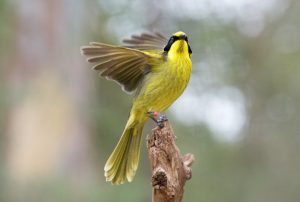26 August 2019

In an exciting first for the species, 37 out-crossed Helmeted Honeyeaters were released to Yellingbo Nature Conservation Reserve throughout August 2019, coinciding with the 30th anniversary of the recovery program to save the species.
Once common in Victoria, the Helmeted Honeyeater is now only found in a single location, 661 hectares of land in Yellingbo.
The Helmeted Honeyeater Recovery Team has been working together to save this precious native bird from extinction, concentrating much of its work on re-establishing the habitat at Yellingbo for the bird, to grow it in size and scale.
In careful trials of gene pool mixing, Zoos Victoria bred Helmeted Honeyeaters at Healesville Sanctuary with their closest relative, the Yellow-tufted Honeyeater. Gene-pool mixing involves breeding individuals that are relatively unrelated to improve genetic diversity. The “out-crossed” birds were bred to try to overcome the harmful effects of inbreeding occurring in the wild Helmeted Honeyeater population.
“Over the 30 years of the recovery program, information and genetic samples were collected that now allow us to understand the harmful effects of inbreeding that could possibly be resolved using gene pool mixing,” said Monash University’s Paul Sunnucks, who led the genetic aspects of the trial with Zoos Victoria.
“Gene pool mixing could help overcome the burden of inbreeding depression and bolster an enduring recovery of the Helmeted Honeyeater.”

Healesville Sanctuary’s Life Sciences Manager, Conservation & Research, Kim Miller, said the mixing of the two subspecies in captivity had been going very well, with no signs of genetic or other problems.
“Over the last 30 years, thanks to the recovery program, the wild population has flourished from around 50 to about 230 today,” Dr Miller said. “It’s exciting to be involved in this important work fighting extinction.”
The Department of Environment, Land, Water and Planning’s Senior Ornithologist, Bruce Quin, has worked on the recovery program for 26 of the 30 years, and says he is still learning more about the birds each day.
“Being part of the recovery team and helping to bring the Helmeted Honeyeater back from the brink of extinction has been a career highlight for me, as is working with all the different agencies and volunteer groups. It is an absolute privilege and joy to do the work we do and we still have a long way to go with the recovery program,” Mr Quin said.

The Helmeted Honeyeater Recovery Team is a voluntary collaboration of conservation organisations including the PPWCMA (via the Yarra4Life program), Department of Environment, Land, Water and Planning, Parks Victoria, La Trobe University, Monash University, Friends of the Helmeted Honeyeater and Zoos Victoria.

